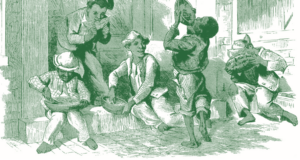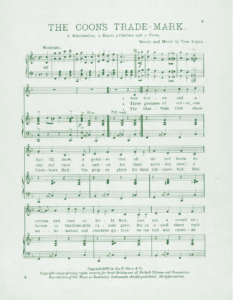A Black woman named Clara was selling watermelons in the streets of Houston, Texas, when she recognized a white boy whose family used to enslave her. She had actually been his nanny until that summer, when the Union’s victory secured her freedom. The boy, little Henry Evans, cried for days when she left—but that grief had apparently hardened into resentment. When Clara offered Henry a watermelon, perhaps as a token of reconciliation, he rejected her and kept walking. He told her “he would not eat what free negroes ate.”
It was in exchanges like this, as well as in jokes and cartoons, that a racist trope was born: the idea that African Americans are overly fond of watermelon. This stereotype still has the power to provoke shame and snickering, and many Black people today are reluctant to eat watermelon in public lest they confirm someone’s prejudice. Every year or so there is some new controversy over the fruit; in 2018, students at NYU balked when a dining hall served watermelon-flavored water in honor of Black History Month, and there was a social-media outcry when the singer Madonna posted photos of her adopted Malawian daughters posing with watermelons. Every time this happens, the inevitable question emerges: what is so bad about watermelons?

Perhaps the earliest printed caricature of African Americans enjoying watermelon, published by Frank Leslie’s Illustrated Newspaper in 1869. The adjoining article explained, “The Southern negro in no particular more palpably exhibits his epicurean tastes than in his excessive fondness for watermelons. The juvenile freedman is especially intense in his partiality for that refreshing fruit.”
It is a good question. How and why did this stereotype emerge? Why watermelon? The answer partly lies in certain characteristics of the fruit itself. Well before the American Civil War, watermelons connoted various things that would later be incorporated into anti-Black imagery: (1) uncleanliness, because watermelons are rather juicy and messy; (2) idleness, because watermelons are too large and cumbersome to eat while you’re working, unlike, say, an apple; (3) childishness, because watermelons are sweet and colorful; and (4) public celebration, because watermelons can be sliced up and divided among a large group of people.
In the Western imagination of the early 19th century,the prototypical watermelon-eater was a languorous peasant in the Mediterranean or the Orient. A British officer fighting Napoleon’s army in Egypt wrote that the watermelon was “a poor Arab’s feast,” with watermelon rinds littering the streets of Rosetta and the locals devouring the fruit “ravenously… as if afraid the passer-by was going to snatch them away.”
But despite these cultural connotations, the watermelon was not an anti-Black symbol in antebellum America. There is no evidence the fruit appeared in the minstrel shows popular before the Civil War. An American in 1850 was just as likely to associate watermelons with a Kentucky hillbilly or a New Hampshire rube as with a South Carolina slave.
This is somewhat surprising given how prominent the watermelon was in the lives of enslaved Americans. Because watermelons are relatively easy to grow, requiring little time or acreage, many slaves would use what free time they had to grow their own watermelon patch. Southern city-dwellers knew well the melodic cries of Black watermelon vendors, who would come into town to sell their crop and earn a little cash: “I got de watermelons and dey are de watermelons”; “Got ’em, got ’em, got ’em nice; got ’em sweet; got ’em cheap.” It was common for enslavers to give their slaves a holiday during the summer to eat the first watermelon harvest.
But when slaveholders saw slaves enjoying watermelon, slaveholders understood this as a sign of their own supposed benevolence. And slaves were usually careful to enjoy watermelon in a way that would not alienate their enslavers. Henry Barnes recounted in the 1930s how, as an enslaved child, his overseer would cut up some watermelons and expect all the children to run to get their slice. Henry refused to run, however, and when he got his slice he dashed off to the slave quarters to eat out of the white people’s sight. His mother later whipped him for being “stubborn.” She understood that her son had to perform the act of watermelon-eating in a certain way, to maintain the illusion that masters and slaves were one harmonious family.
The Civil War shattered that illusion, and as a result, white Americans saw Black watermelon culture in a different light. When Black people cultivated watermelon patches and sold watermelons at crossroads and train stations, it was no longer a token of white people’s generosity; it was a way for Black people to escape white people’s control and earn money outside the plantation system. When freedpeople celebrated the Fourth of July by slicing up a bunch of watermelons in the courthouse square, white people no longer saw it as a sign of interracial harmony—they saw it instead as a sign that childish Black people were flaunting their freedom.
It was only at this point, when the Confederacy was defeated and African Americans gained their freedom, that anti-Black watermelon jokes began to proliferate in print. In 1867, a Charleston newspaper belittled Black watermelon vendors, writing, “The sale of the fruit affords an occupation to numbers of industrious (?) freedmen who lazily pursue their calling.” (Only a few months later, this same paper praised a white farmer for making “one hundred dollars from the sale of Watermelons.”) In 1870, the New-York Tribune claimed that the former slave “lives in the present, thinking little of the past or the future; a bottle of whisky or a watermelon today is more prized by him than a farm or a fortune twenty years hence.” In one joke, a Black man approaching the gallows lamented, “I wish dey had put it off till after watermelon time.”
The main theme of the racist watermelon trope was that Black people were not yet ready for freedom. As white Americans saw it, freedpeople’s proclivity for a childish, messy fruit—a fruit more conducive to relaxation than labor—was evidence that they were unfit for citizenship.
This became the dominant public memory of Reconstruction, which most whites saw as a failed experiment in granting political power to Black people. During the 1880 election season, Democrats accused the South Carolina state legislature, which had been majority-black during Reconstruction, of having wasted taxpayers’ money on watermelons for their own refreshment; this fiction even found its way into history textbooks. D. W. Griffith’s white-supremacist epic film The Birth of a Nation, released in 1915, included a watermelon feast in its depiction of emancipation, as corrupt northern whites encouraged the freedpeople to stop working and enjoy some watermelon instead.

By the early 20th century, the watermelon had become central to anti-Black iconography. The advent of sheet music allowed the racist trope to proliferate wider than ever. From: The coon’s trade-mark (1898). Music Division, The New York Public Library.
By the early 20th century, the watermelon stereotype was everywhere—on paperweights and potholders, on sheet music and salt-and-pepper shakers. Probably few Americans realized how recent the stereotype was, and today the stereotype seems to exist outside of history. But the trope was very much born at a specific historical moment and served a specific political purpose. Black freedpeople grew, ate, and sold watermelons, and in doing so made the fruit a symbol of their newfound freedom. White Americans, who felt threatened by that freedom, responded by inverting the fruit’s symbolic meaning—making the watermelon an avatar of Black people’s supposed uncleanliness, idleness, and childishness. The trope’s ability to obscure that history, and make all the jokes and postcards seem relatively innocuous, is the source of its power.
